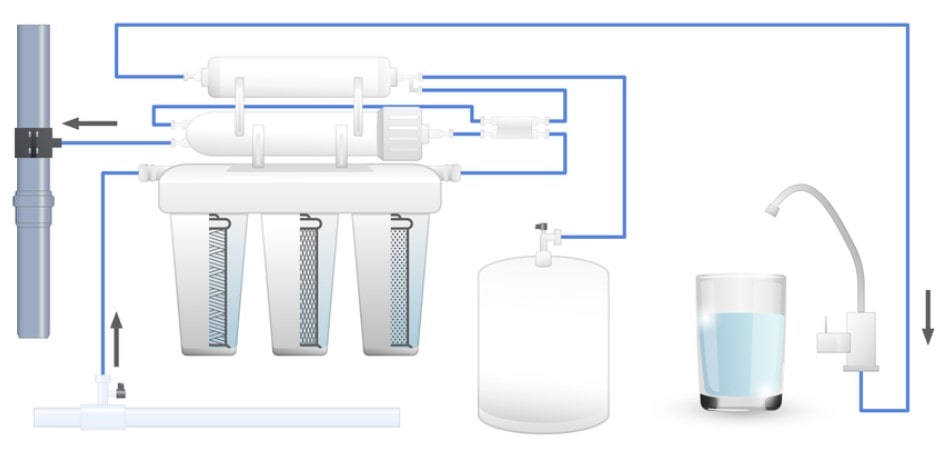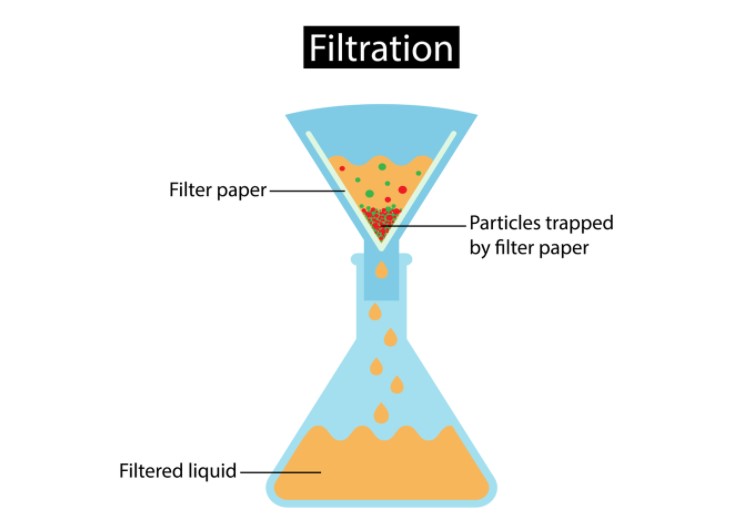The factors influencing filtration, or the most important factors on which filtration depends, are:
(i) Proportion of solids in the slurry
(ii) properties of the liquid, namely density, viscosity, corrosiveness, etc.
(iii) properties of the solid, such as particle shape, size, size distribution, and compressibility.
(iv) The properties of the filter medium, especially resistance, and the initial layers of cake form.

Table of Contents
The following are the factors that influence the rate of filtration:-Factors influencing filtration
(i) Permeability Coefficient-Factors influencing filtration
According to Darcy’s equation permeability coefficient (K) represents the resistance of both the filter medium and the filter cake. As the thickness of the cake increase, the rate of filtration decreases. Also, the surface area of the particles, the porosity of the cake, and the rigidity or compressibility of the particles could also affect the permeability of the cake.
(ii) Area of Filter Medium
The total volume of filtrate flowing through the filter is proportional to the area of the filter. The area can be increased by using larger filters. For example, in the rotary drum filter, the continuous removal of the filter cake gives an infinite area for filtration.
(iii) Pressure Drop
The rate of filtration is proportional to the pressure difference across both the filter medium and filter cake. The pressure drop can be achieved in a number of ways:
Gravity: A pressure difference could be obtained by maintaining a sufficient head of slurry above the filter medium. The pressure developed will depend on the density of the slurry.
Vacuum: The pressure below the filter medium may be reduced below atmospheric pressure by connecting the filtrate receiver to a vacuum pump and creating a pressure difference across the filter.
Pressure: The simplest method is to pump the slurry onto the filter under pressure.
Centrifugal force: Application of higher centrifugal force on slurry increases the rate of filtration.
(iv) Viscosity of Filtrate
It is considered that an increase in the viscosity of the filtrate increases the resistance of flow so that the rate of filtration is inversely proportional to the viscosity of the fluid. This problem can be overcome by two methods:
Temperature: The rate of filtration may be increased by raising the temperature of the liquid, which lowers its viscosity. However, it is not practicable if thermolabile materials are involved or if the filtrate is volatile.
Dilution: Dilution is another alternative but the rate must be doubled.
(v) Thickness of Filter Cake
The rate of flow of the filtrate through the filter cake is inversely proportional to the thickness of the cake. Preliminary decantation may be useful to decrease the number of solids that ultimately help to increase the filtration rate.
(vi) Particle Size of Solids-Factors influencing filtration
Generally the larger the particle size the higher the filtration rate (Kg/m2/h). A small average particle size, a narrow distribution range have a high filtration rate.
(vii) Ratio of Slimes to Coarser Particles
The slimes (or extreme fines) in a slurry affect filtration rates to a vastly greater extent than their percentage. Particularly, the difficult slurry is one that contains relatively coarse particles and a number of very fine or slimy particles with little or no intermediate size.
(viii) Flocculation/Dispersion of Fine Solids
flocculation is generally desirable for slurries of fine solids which are in a dispersed state and generally filter poorly. The wide variety of polyelectrolyte flocculants provides space for a substantial improvement in filtration rates. Effective use of flocculants, especially polyelectrolytes, on moderately high concentration slurry requires strong agitation to get good solids-flocculant contact. A minimum of further agitation and minimum aging are important. Some slurry may be so viscous as to create filtering problems and a dispersant may be a better way to gain fluidity than dilution.
(ix) Slurry Age-Factors influencing filtration
Sometimes processes involve detention times which provide a conditioning effect modifying filter performance. Samples stored for a longer time for testing involve a risk that excessive aging may have some effect on filtration.
(x) Agitation Speed
Some slurry, particularly with a wide particle size range tends to classify in the test slurry container or the filter tube. Increasing the agitation speed (or stirring) to a point that the coarse and fine particles are always thoroughly mixed may be desirable. A too high speed could limit cake thickness; prevent coarser particles from forming in the cake or cause delicate flocs to break down.
(xi) Cycle Time
Cycle time of the filter drum speed is generally expressed in seconds or minutes per revolution. Generally the faster the drum speed the higher the output. However, under these conditions, the cake is thinner and sometimes wetter, so discharge may deteriorate. At all times, a dischargeable cake must be produced.
(x) Cake Compression
Cake compression is normally achieved as an adjunct to the filtration step to reduce cake moistures of compressible cakes.
(xi) Type of Filter Medium
Filtering characteristics of fabrics depend mostly on the type of yarn and weave. Yarns can be monofilament, multi-filament, spun from staple fiber, or a combination of the latter two. A high twist can make a multi-filament perform more like a mono-filament. Permeability and porosity are prime qualities in cloth selection. The Frazier permeability rating, expressed as cfm/sq ft is a measure of airflow at one-half inch water pressure through a dry cloth, and is comparable to percent open area. Porosity and particle retention may not be accurately indicated by permeability; there being no direct measure of porosity.
(xii) Filter Cloth Condition
Cloth conditioning refers to the reduction of pore size or the open area due to the entrapment of fine solids in the interstices
(xiii) Filter Aids-Factors influencing filtration
Filter aids like diatomaceous earth, perlite, powdered coal, and fly-ash or paper pulp may be added to the slurry to increase its filtration rate and cake porosity.
(xiv) Solid Concentration in Slurry
In general, the greater the percentage of suspended solids in a given slurry, the higher the cake filter rate in Kg/m2 /h and the lower the filter rate in m3 /m2 /h. Where maximum solids capacity is desired it is advisable to consider thickening the slurry by gravity. In some applications involving thickening with sludge recycling, particle size is actually increased and both cake and filtrate rates can increase.
(xv) Filter Thickening
Filter thickening normally occurs in a continuous filter rotating in a tank containing slurry wherein the solids in the filter tank increase in concentration and shift to a coarser size distribution. While an equilibrium concentration and size distribution are usually obtained, it may sometimes be necessary to dilute the pulp.
(xvi) Slurry pH-Factors influencing filtration
The slurry pH and particle dispersion are closely related. The change in pH can be one of the most effective methods to achieve flocculation and thus the improved filterability.
Applications of filtration
